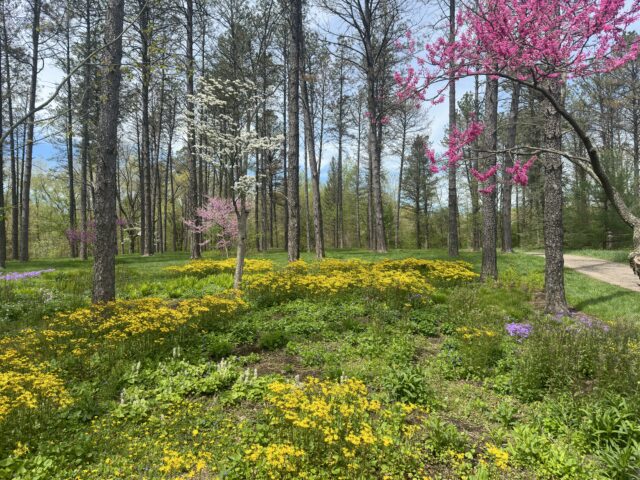Beech Leaf Disease Research Update: The Impact on Microbial Communities
May 22, 2024

FOR IMMEDIATE RELEASE
(KIRTLAND) May 21, 2024 – Beech leaf disease is an emerging threat to American beech trees in the Great Lakes Region and northeastern U.S. Caused by a non-native, wormlike animal, the nematode Litylenchus crenatae subsp maccannii, infestations affect beech leaves at the cellular level, hindering their growth and ability to photosynthesize. The disease can lead to premature leaf drop and, in severe cases, tree death.
Researchers at Holden Forests & Gardens, led by Dr. David Burke, Vice President for Science and Conservation, have been studying the mechanisms of beech leaf disease since 2017, when the nematode associated with the disease was first identified. Since then, researchers have confirmed the nematode is the cause of the disease, though possible additional associations with bacteria or fungi had remained unclear.
“From our previous work, we knew that BLD was somehow affecting the bacteria communities on beech leaves, specifically,” says Burke. “This new study allowed us to explore how leaf microbial communities change across different sites, as well as to explore the impacts of nematodes and BLD symptoms separately.”
In the new study, published today in the journal Applied and Environmental Microbiology, the Burke lab group presents results from recent surveys of bacteria, fungi, and nematodes they conducted on beech trees across nine sites across Ohio and Pennsylvania with different levels of disease symptoms. Their goal was to understand how nematode infestation and BLD symptoms impact the communities of bacteria and fungi that live on the leaves of beech trees.
Learn more about beech leaf disease: What causes it, what you can do about it, and the latest research from the experts at Holden Forests & Gardens
The team found significantly higher levels of nematode infestation in trees showing visible symptoms of BLD, as they expected. Interestingly, they also found low levels of nematode presence in some areas where trees appeared healthy, suggesting that nematodes can colonize a tree without immediately causing visible damage.
Additionally, trees with and without BLD symptoms had consistent differences in their leaf bacteria and fungi, in both cases mainly driven by a few key species found in higher amounts in symptomatic leaves. These “indicator” species are present in low abundances on non-diseased leaves as well, suggesting they are opportunistic — taking advantage of the weakened tree, for instance — rather than playing a role in causing the symptoms.
Although both bacteria and fungi showed effects from BLD, only the fungi seemed to respond to the presence of the nematodes alone, regardless of disease progression.
Finally, one microbial species stood out to the researchers: a fungi called Erysiphe, which can cause powdery mildew and is known to infect beech trees. This fungus was consistently found in greater abundances across all the symptomatic sites. It’s an interesting link since the fungus is known to overwinter in buds — just like the nematodes. It’s also known that more severe outbreaks of powdery mildew can follow pest-related defoliation events. The researchers flag this finding as an important avenue for additional research, to study whether Erysiphe plays a role in worsening BLD symptoms.
“It was interesting to see how different species of bacteria and fungi are changing under BLD at different sites,” says Burke. “I look forward to further studies that will dig into how these microbes are in turn affecting the health of the beech trees.”
This study sheds light on the role of important members of the beech leaf disease ecosystem: the bacteria and fungi that live on beech leaves. These microbial communities live alongside the nematodes when a tree is infested, and therefore have the potential to help, hurt, or simply react to the impacts of BLD. These findings also highlight the importance of considering both the direct and indirect effects of nematode infestations on trees, since they might provide important clues for developing effective treatments for the disease.
Citation: Burke, D.J., S.R. Carrino-Kyker, A.J. Hoke, E. Galloway, D. Martin, and L. Chick. 2024. Effects of the nematode Litylenchus crenatae subsp. mccannii and beech leaf disease on leaf fungal and bacterial communities on Fagus grandifolia (American beech). Applied and Environmental Microbiology. DOI: 10.1128/aem.00142-24
About Holden Forests & Gardens: Holden Forests & Gardens is made up of two of Northeast Ohio’s most important environmental and cultural institutions — the Holden Arboretum and Cleveland Botanical Garden — whose mission is to connect people with the wonder, beauty, and value of trees and plants, to inspire action for healthy communities. One of the largest public gardens in the country, Holden Forests & Gardens has 21,000 member households and an annual attendance of nearly 350,000 for whom we strive to provide inspirational and educational visitor experiences. For more information, visit holdenfg.org.
Corresponding Author:
Dr. David Burke, Vice President of Science & Conservation
Holden Forests & Gardens
dburke@holdenfg.org
Media Contact:
Dr. Anna Funk, Science Communications Specialist
Holden Forests & Gardens
afunk@holdenfg.org

Anna Funk, PhD
Science Communications Specialist
Anna Funk is the Science Communication Specialist for Holden Forests & Gardens. She earned her Ph.D. studying prairie restoration before leaving the research world to help tell scientists’ stories. Today, she wears many hats, working as a writer, editor, journalist and more — anything that lets her share her appreciation of science and its impact with others.











